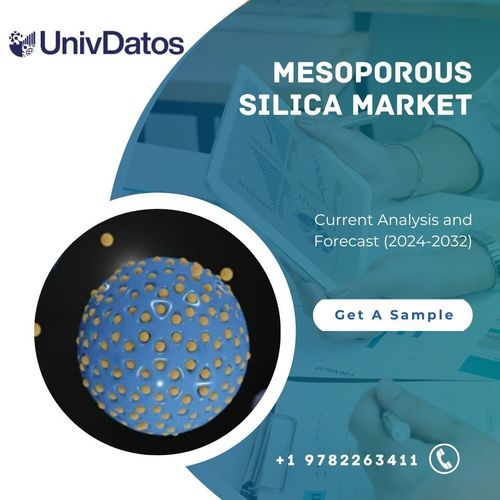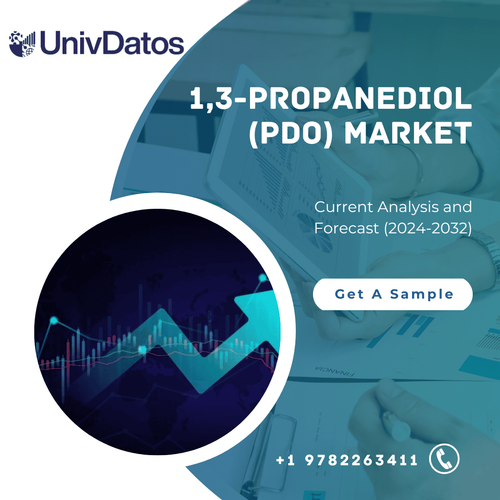Taxifolin Market: Current Analysis and Forecast (2023-2030)
Emphasis on Purity (Less Than 95% and Greater Than Equal To 95%), Application (Aluminized, Acrylic, Silicone, and Others); End-User (Foods and Beverages, Cosmetics, Healthcare, and Agriculture); and Region/Country
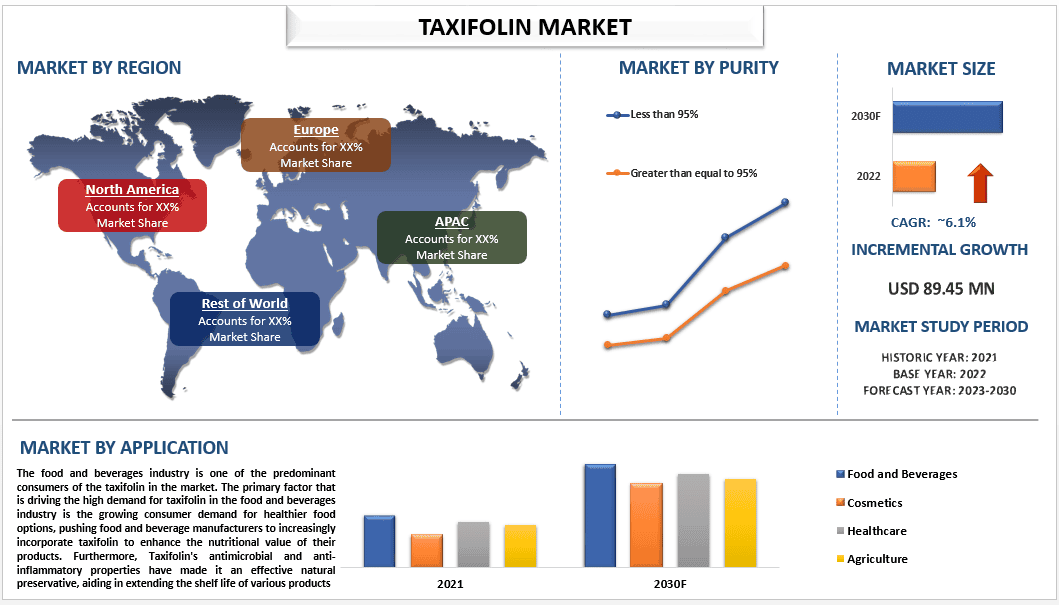
The Taxifolin Market was valued at 89.45 million in the year 2022 and is expected to grow at a strong rate of around 6.1% during the forecast period (2023-2030), owing to the growing health and wellness industry. Furthermore, rising inflammatory diseases among the population due to unhealthy and sedentary lifestyles are playing a pivotal role in the growing demand for taxifolin in the market. Taxifolin exhibits anti-inflammatory effects, inhibiting the production of pro-inflammatory molecules and promoting a healthy inflammatory response. For instance, the study done on taxifolin by the National Institutes of Health suggests that taxifolin possesses the ability to improve the inflammatory damage inflicted upon RAW264.7 cells by regulating various agents involved in oxidative stress and inflammatory reactions. This indicates that taxifolin holds immense promise for further investigation in the realm of treating inflammatory disorders. This characteristic makes taxifolin a potentially valuable component in alleviating symptoms associated with inflammatory conditions such as arthritis, asthma, and certain skin conditions.
Some of the major players operating in the market include Ametis JSC; JW Health Products Pty Ltd; Cayman Chemical; Ebrator Biochemicals; Adooq Bioscience LLC.; Creative Enzymes.; BOC Sciences; Nature Science Technologies; Alfa Chemistry; and United States Biological. Several M&As along with partnerships have been undertaken by these players to facilitate customers with hi-tech and innovative products/technologies.
Insights Presented in the Report
“Amongst Purity, the less than 95% segment held the significant market share in 2022.”
Based on purity, the market is bifurcated into less than 95% and greater than equal to 95%. Taxifolin, with purity less than 95% dominates the market with the largest share. One of the primary factors driving the dominance of taxifolin with a purity of less than 95% is its cost-effectiveness. Lower purity forms of taxifolin are generally cheaper to produce, making them more affordable for manufacturers, and attracting a larger customer base. Furthermore, Taxifolin finds applications in various industries, including pharmaceuticals, cosmetics, and food and beverages. For several applications, taxifolin with lower purity can suffice without compromising product quality or efficacy. This compatibility enables manufacturers to meet market demands by providing taxifolin with purity levels below 95%, which is sufficient for many applications.
“Amongst application, the food and beverage industry held a significant share of the market in 2022.”
Based on application, the market is segmented into foods and beverages, cosmetics, healthcare, and agriculture. The food and beverages industry is one of the predominant consumers of taxifolin in the market. The primary factor that is driving the high demand for taxifolin in the food and beverages industry is the growing consumer demand for healthier food options, pushing food and beverage manufacturers to increasingly incorporate taxifolin to enhance the nutritional value of their products. Furthermore, Taxifolin’s antimicrobial and anti-inflammatory properties have made it an effective natural preservative, aiding in extending the shelf life of various products. By inhibiting the growth of spoilage-causing microorganisms, taxifolin has emerged as a valuable tool for ensuring product freshness and minimizing waste, factors like these have played a vital role in the growing demand for taxifolin in the foods and beverages industry.
Taxifolin Market Report Coverage
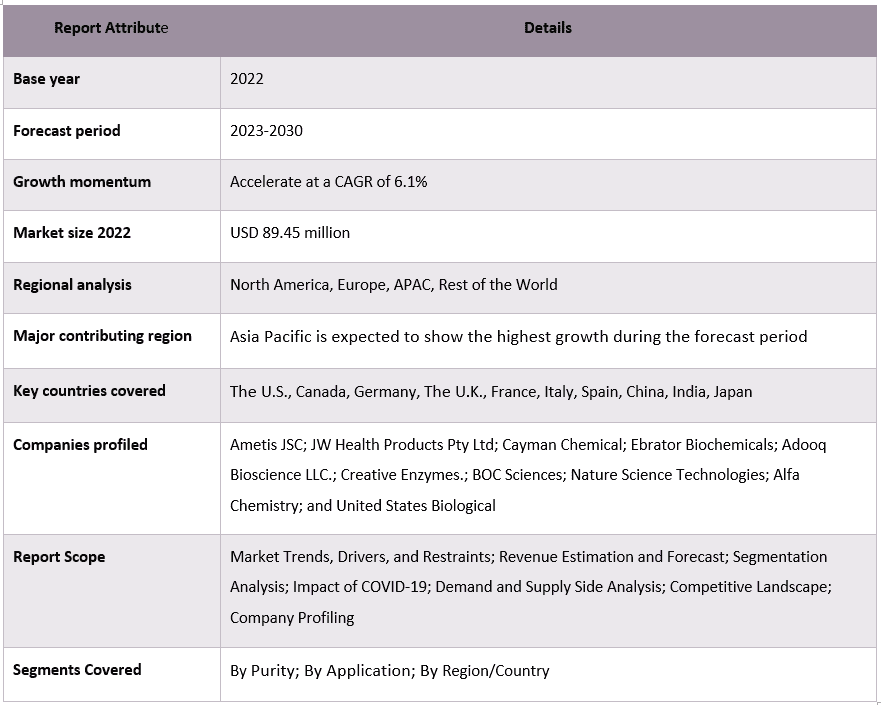
“Asia Pacific is anticipated to witness a significant growth during the forecast year (2023-2030).”
Asia Pacific is emerging as one of the fastest-growing markets for taxifolin products. One of the primary factors that is driving the high growth of taxifolin products is the growing nutraceutical and dietary supplements industry. Taxifolin is being used as an active ingredient in these products due to its potential health benefits, further driving up the demand. Furthermore, the region has observed an increase in chronic diseases such as cardiovascular diseases, diabetes, and cancer. Taxifolin’s potential protective effects against these conditions have prompted its usage in functional foods and beverages, attracting a growing consumer base. Additionally, as disposable incomes rise in many countries across the Asia Pacific, consumers have more purchasing power to invest in premium health products. Taxifolin, positioned as a beneficial ingredient, is being incorporated into higher-quality products to cater to this trend.
Reasons to buy this report:
- The study includes market sizing and forecasting analysis validated by authenticated key industry experts.
- The report presents a quick review of overall industry performance at one glance.
- The report covers an in-depth analysis of prominent industry peers with a primary focus on key business financials, product portfolios, expansion strategies, and recent developments.
- Detailed examination of drivers, restraints, key trends, and opportunities prevailing in the industry.
- The study comprehensively covers the market across different segments.
- Deep dive regional level analysis of the industry.
Customization Options:
The global taxifolin market can further be customized as per the requirement or any other market segment. Besides this, UMI understands that you may have your own business needs, hence feel free to contact us to get a report that completely suits your requirements.
Table of Contents
1. Market Introduction
- Market Definitions
- Main Objective
- Stakeholders
- Limitation
2. Research Methodology Or Assumption
- Research Process of the Taxifolin Market
- Research Methodology of the Taxifolin Market
- Respondent Profile
3. Market Synopsis
- Market Synopsis
4. Executive Summary
- Executive Summary
5. Impact Of Covid-19 On The Taxifolin Market
- Impact Of Covid-19 On The Taxifolin Market
6. Taxifolin Market Revenue (usd Bn), 2020-2030f.
- Taxifolin Market Revenue (usd Bn), 2020-2030f.
7. Market Insights By Purity
- Less than 95%
- Greater than equal to 95%
8. Market Insights By Application
- Food and Beverages
- Cosmetics
- Healthcare
- Agriculture
9. Market Insights By Region
- North America
- The U.S.
- Canada
- Rest of North America
- Europe
- Germany
- The U.K.
- France
- Italy
- Spain
- Rest of Europe
- Asia-Pacific
- China
- India
- Japan
- South Korea
- Rest of Asia-Pacific
- Rest of the World
- North America
10. Taxifolin Market Dynamics
- Market Drivers
- Market Challenges
- Impact Analysis
11. Taxifolin Market Opportunities
- Taxifolin Market Opportunities
12. Taxifolin Market Trends
- Taxifolin Market Trends
13. Demand And Supply-side Analysis
- Demand Side Analysis
- Supply Side Analysis
14. Value Chain Analysis
- Value Chain Analysis
15. Competitive Scenario
- Competitive Landscape
- Porters Fiver Forces Analysis
- Competitive Landscape
16. Company Profiled
- Ametis JSC
- JW Health Products Pty Ltd
- Cayman Chemical
- Ebrator Biochemicals
- Adooq Bioscience LLC.
- Creative Enzymes.
- BOC Sciences
- Nature Science Technologies
- Alfa Chemistry
- United States Biological
17. Disclaimer
- Disclaimer
Research Methodology for the Taxifolin Market Analysis (2023-2030)
Analyzing the historical market, estimating the current market, and forecasting the future market of the global taxifolin market were the three major steps undertaken to create and analyze the adoption of taxifolin in major regions globally. Exhaustive secondary research was conducted to collect the historical market numbers and estimate the current market size. Secondly, to validate these insights, numerous findings and assumptions were taken into consideration. Moreover, exhaustive primary interviews were also conducted, with industry experts across the value chain of the global taxifolin market. Post assumption and validation of market numbers through primary interviews, we employed a top-down/bottom-up approach to forecasting the complete market size. Thereafter, market breakdown and data triangulation methods were adopted to estimate and analyze the market size of segments and sub-segments of the industry pertains to. Detailed methodology is explained below:
Analysis of Historical Market Size
Step 1: In-Depth Study of Secondary Sources:
A detailed secondary study was conducted to obtain the historical market size of the taxifolin market through company internal sources such as annual reports & financial statements, performance presentations, press releases, etc., and external sources including journals, news & articles, government publications, competitor publications, sector reports, third-party database, and other credible publications.
Step 2: Market Segmentation:
After obtaining the historical market size of the taxifolin market, we conducted a detailed secondary analysis to gather historical market insights and share for different segments & sub-segments for major regions. Major segments are included in the report as purity and application. Further country-level analyses were conducted to evaluate the overall adoption of testing models in that region.
Step 3: Factor Analysis:
After acquiring the historical market size of different segments and sub-segments, we conducted a detailed factor analysis to estimate the current market size of the Taxifolin market. Further, we conducted factor analysis using dependent and independent variables such as purity and application of the taxifolin market. A thorough analysis was conducted for demand and supply-side scenarios considering top partnerships, mergers and acquisitions, business expansion, and product launches in the taxifolin market sector across the globe.
Current Market Size Estimate & Forecast
Current Market Sizing: Based on actionable insights from the above 3 steps, we arrived at the current market size, key players in the global Taxifolin market, and market shares of the segments. All the required percentage shares split and market breakdowns were determined using the above-mentioned secondary approach and were verified through primary interviews.
Estimation & Forecasting: For market estimation and forecast, weights were assigned to different factors including drivers & trends, restraints, and opportunities available for the stakeholders. After analyzing these factors, relevant forecasting techniques i.e., the top-down/bottom-up approach were applied to arrive at the market forecast for 2030 for different segments and sub-segments across the major markets globally. The research methodology adopted to estimate the market size encompasses:
- The industry’s market size, in terms of revenue (USD) and the adoption rate of the taxifolin market across the major markets domestically
- All percentage shares, splits, and breakdowns of market segments and sub-segments
- Key players in the global taxifolin market in terms of products offered. Also, the growth strategies adopted by these players to compete in the fast-growing market.
Market Size and Share Validation
Primary Research: In-depth interviews were conducted with the Key Opinion Leaders (KOLs) including Top Level Executives (CXO/VPs, Sales Head, Marketing Head, Operational Head, Regional Head, Country Head, etc.) across major regions. Primary research findings were then summarized, and statistical analysis was performed to prove the stated hypothesis. Inputs from primary research were consolidated with secondary findings, hence turning information into actionable insights.
Split of Primary Participants in Different Regions
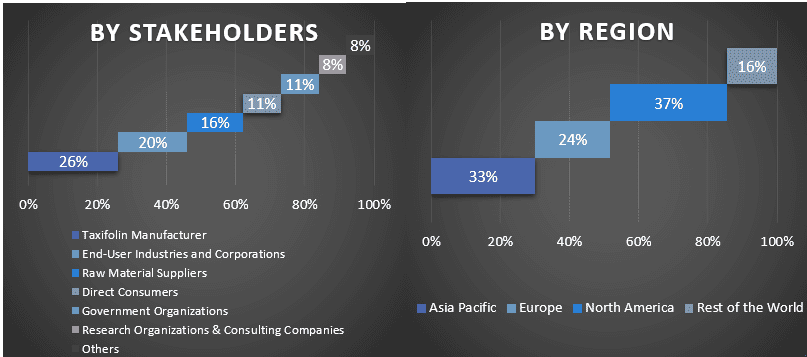
Market Engineering
The data triangulation technique was employed to complete the overall market estimation and to arrive at precise statistical numbers for each segment and sub-segment of the global taxifolin market. data was split into several segments & sub-segments post studying various parameters and trends in the areas of purity and application in the global taxifolin market.
The main objective of the Global Taxifolin Market Study
The current & future market trends of the global taxifolin market were pinpointed in the study. Investors can gain strategic insights to base their discretion for investments on the qualitative and quantitative analysis performed in the study. Current and future market trends determined the overall attractiveness of the market at a regional level, providing a platform for the industrial participant to exploit the untapped market to benefit from a first-mover advantage. Other quantitative goals of the studies include:
- Analyze the current and forecast market size of the taxifolin market in terms of value (USD). Also, analyze the current and forecast market size of different segments and sub-segments.
- Segments in the study include areas of purity and application.
- Define and analyze the regulatory framework for the taxifolin
- Analyze the value chain involved with the presence of various intermediaries, along with analyzing customer and competitor behaviors of the industry.
- Analyze the current and forecast market size of the taxifolin market for the major region.
- Major countries of regions studied in the report include Asia Pacific, Europe, North America, and the Rest of the World
- Company profiles of the taxifolin market and the growth strategies adopted by the market players to sustain in the fast-growing market.
- Deep dive regional level analysis of the industry
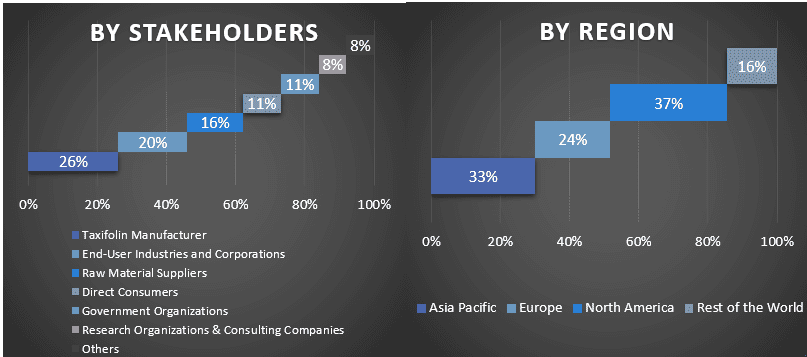
You can also purchase parts of this report. Do you want to check out a section wise
price list?
Frequently Asked Questions FAQs
Q1: What is the current market size and growth potential of the global Taxifolin market?
Q2: What are the driving factors for the growth of the global Taxifolin Market?
Q3: Which segment has the largest share of the global Taxifolin market by Purity?
Q4: What are the emerging technologies and trends in the global Taxifolin market?
Q5: Which region will dominate the global Taxifolin market?
Q6: Who are the key players operating in the global Taxifolin market?
Related Reports
Customers who bought this item also bought








